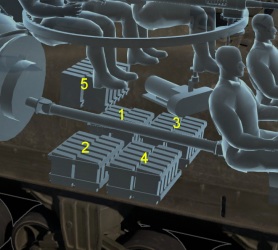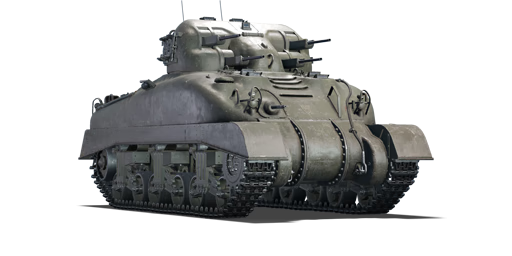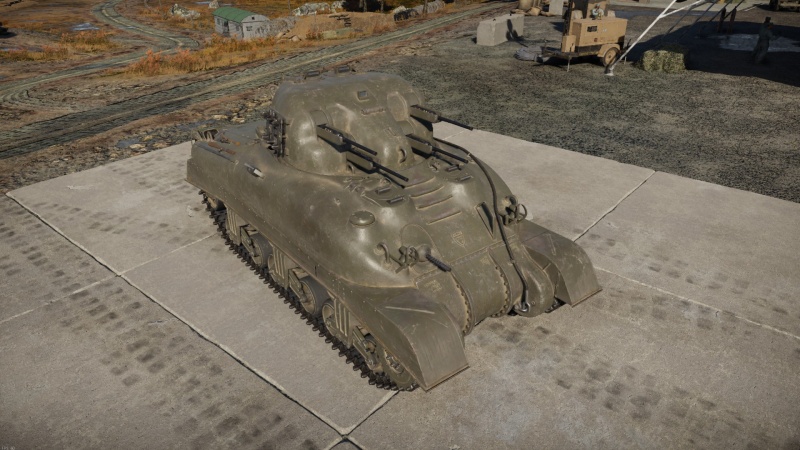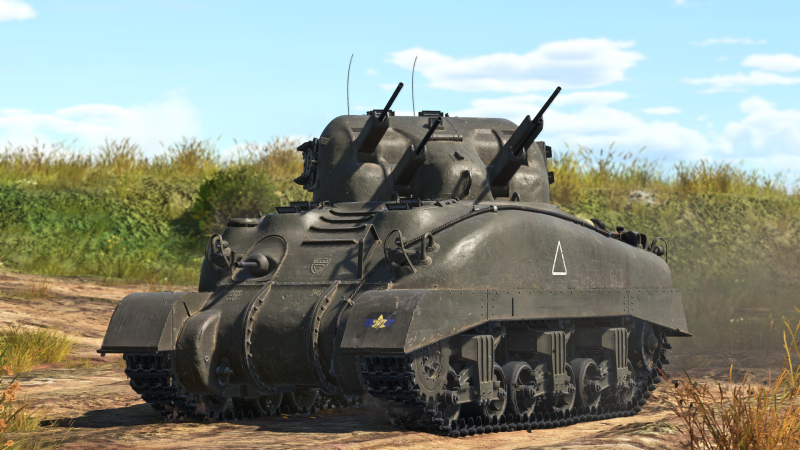Skink
Contents
Description
The Skink, Tank, Anti-Aircraft, 20mm, Quad is a rank IV British SPAA with a battle rating of 6.0 (AB) and 5.3 (RB/SB). It was introduced in Update "Drone Age".
A British and Canadian project for a self-propelled anti-aircraft gun to protect their armoured force, the Skink was a step above the Crusader AA options with four 20 mm autocannons in an enclosed mount. While the Skink never got a chance to shoot down an enemy aircraft during World War II, players would have the chance to light up the skies to shoot down enemy pilots.
General info
Survivability and armour
Overall, the Skink offers a protection similar to the Sherman. Based on the Sherman itself, only the turret offers a lower protection than its medium tank cousin. Compared to SPAAs at this rank, this will offer a much higher survivability thanks to the armour thickness close to a medium tank at this rank, since the crew is completely protected inside the tank. The roof of the tank itself is still fairly thick and can resist 12.7 mm MG rounds from above, which makes it a rather hard target for strafing aircraft. Only heavy aircraft guns, direct rocket hits, and bombs can actually destroy it.
Against ground targets, the Skink will not be that well protected. Ar this BR, most tanks will have little difficulty penetrating this level of armour even at some distance. It would not be the best choice to fight against the ground targets. The protection remains good enough against HMGs and most 20 mm guns. Some lighter vehicles might also have difficulty to penetrate the Skink. Against vehicles at a lower battle rating, the front might be protected enough to take the hit of a 75 mm or 76.2 mm gun once in a while. The side is very flat and offers just enough protection against WW2 autocannons. Any tank gun could easily penetrate the sides.
Armour type:
- Cast homogeneous armour (hull and turret)
| Armour | Front (Slope angle) | Sides | Rear | Roof |
|---|---|---|---|---|
| Hull | 50.8 mm (30-50°) Front Glacis 50.8 mm (0-34°) Transmission cover |
50.8 mm front quater 38.1 mm all the rest |
38.1 mm (13°) lower part 38.1 mm upper part |
19.5 mm |
| Turret | 50.8 mm (round) gun's mantle 38 - 57 mm (variable thickness) front |
38.1 mm | 25 mm | 38 mm front half 24 mm rear half |
Notes:
- 19.5 mm neck guard protect the turret transverse
- 5 mm mudgard
- 20 mm track
- 20 mm track are attached on the side of the turret
Mobility
The Skink has mobility comparable to that of the M4 Sherman variants. It has average forward mobility, but a poor reverse gear.
| Game Mode | Max Speed (km/h) | Weight (tons) | Engine power (horsepower) | Power-to-weight ratio (hp/ton) | |||
|---|---|---|---|---|---|---|---|
| Forward | Reverse | Stock | Upgraded | Stock | Upgraded | ||
| Arcade | 35 | 5 | 27.7 | 568 | 763 | 20.51 | 27.55 |
| Realistic | 33 | 5 | 354 | 400 | 12.78 | 14.44 | |
Modifications and economy
Armaments
Main armament
The 20 mm Polsten cannons have a decent rate of fire, as well as a good muzzle velocity.
| 20 mm Polsten (x4) | Turret rotation speed (°/s) | Reloading rate (seconds) | ||||||||||||
|---|---|---|---|---|---|---|---|---|---|---|---|---|---|---|
| Mode | Capacity (Belt) | Fire rate | Vertical | Horizontal | Stabilizer | Stock | Upgraded | Full | Expert | Aced | Stock | Full | Expert | Aced |
| Arcade | 1,920 (30) | 450 | -5°/+80° | ±180° | N/A | 55.5 | 76.8 | 93.2 | 103.1 | 109.7 | 5.20 | 4.60 | 4.24 | 4.00 |
| Realistic | 37.5 | 44.1 | 53.6 | 59.2 | 63.0 | |||||||||
Ammunition
- Default: AP-T · HEF-I · AP-T
- HET: HEFI-T · HEF-I · HEF-I
- APT: AP-T
| Penetration statistics | |||||||
|---|---|---|---|---|---|---|---|
| Ammunition | Penetration @ 0° Angle of Attack (mm) | ||||||
| 10 m | 100 m | 500 m | 1,000 m | 1,500 m | 2,000 m | ||
| HEF-I | 4 | 4 | 3 | 3 | 3 | 3 | |
| AP-T | 38 | 35 | 23 | 14 | 9 | 5 | |
| HEFI-T | 4 | 4 | 3 | 3 | 3 | 3 | |
| Shell details | ||||||||||||
|---|---|---|---|---|---|---|---|---|---|---|---|---|
| Ammunition | Velocity (m/s) |
Projectile mass (kg) |
Fuse delay (m) |
Fuse sensitivity (mm) |
Explosive mass (TNT equivalent) (g) |
Ricochet | ||||||
| 0% | 50% | 100% | ||||||||||
| HEF-I | 838 | 0.12 | 0 | 0.1 | 6 | - | - | - | ||||
| AP-T | 830 | 0.14 | - | - | - | 47° | 60° | 65° | ||||
| HEFI-T | 838 | 0.12 | 0.1 | 0.1 | 5 | 79° | 80° | 81° | ||||
Ammo racks

| Full ammo |
1st rack empty |
2nd rack empty |
3rd rack empty |
4th rack empty |
5th rack empty |
Visual discrepancy |
|---|---|---|---|---|---|---|
| 64 | 48 (+16) | 36 (+28) | 24 (+40) | 12 (+52) | 0 (+64) | No |
Notes:
- Ammunition is modeled as 4 clips of 30 rounds each.
- 64 clips of 30 rounds represent 1,920 rounds.
- The Skink has 5 ammo racks, all stored in the hull. Every rack contains 12 clips, with an additional 4 belts already loaded in the guns when the game begins. Magazines deplete by sets of 4.
Machine guns
The Skink has a single hull-mounted L3A1 machine gun. Due to its low range of traverse, as well as its lackluster damage, it is useless for dealing damage to the enemy unless they are open-topped. It is best used to clear out obstacles which may block your line of sight.
| 7.62 mm L3A1 | ||||
|---|---|---|---|---|
| Mount | Capacity (Belt) | Fire rate | Vertical | Horizontal |
| Hull | 2,000 (250) | 500 | +15°/-5° | -10°/+5° |
Usage in battles
The Skink's anti-air capability is very good, however, at its BR, it is inadequate for taking out most ground vehicles it faces, with the exception of light tanks and other SPAA. For shooting down enemy aircraft, be sure to let them come to you, and fire only when you are confident you can land a hit. If you spray them from too far away, most aircraft will likely avoid your general location so as to not get shot down. Make sure to not let the enemy aircraft know where you are, and surprise them with a devastating burst once they come in range.
Pros and cons
Pros:
- 5 crew members, difficult to knock out in one pass
- M4A1 chassis and closed turret provide protection against autocannons, HMGs, and overpressure damage from bombs and rockets
- Excellent turret traverse and elevation speed
- 4 x 20 mm cannons do excellent damage against aircraft and lightly armoured vehicles
- Short reload time
- Plenty of ammo
Cons:
- Average mobility
- Short ammo belt
- Cannons overheat quickly with continuous fire
- Poor anti-tank capabilities, can only engage lightly-armoured targets
History
In May 1943, the G.O.C.-in-C. of the First Canadian Army requested a vehicle be developed that had the following requirements:
- Accommodate 4 guns
- Ammunition stowage for one minute of fire
- 360° traverse at minimum 40° per second and maximum 50° per second.
The requirement for AA at the time could only be filled by using the Crusader or American AA equipment. However, the First Canadian Army did not want to use the Crusader AA, and information requests for American equipment at the time were not forthcoming. The project was assigned project number 47(DVA).
Since Canada was at the time a dominion of Great Britain, a lot of military technologies and reports were shared between them. From the beginning of development, Great Britain and the USA showed great interest in the project. Great Britain's interest was strong as development of the Crusader AA Mk II had only just began, and the War Office wanted to see which one would end up being better to procure for their forces.
On February 28th, 1944, Project No. 47(DVA) was officially reclassified and given the name "Skink". The name had been given to the tank before then, however officially it had still been named Project No. 47.
The initial idea was to make turret kits that could be fitted to Shermans; the turrets were initially going to be fitted with a quad Hispano 20 mm gun mount using 50-round boxes, though there were also plans to use a belt-fed system. During development, the armament was swapped to Polsten guns, as requested by the British War Office as well as recommended by the First Canadian Army. This change of armament set back the already delayed development stage of the Skink as they had to redesign the turret to accommodate the Polsten guns.
Great Britain at this time had planned to order 130 turret kits which then turned into 130 complete Skinks; however, in August 1944, they called for a complete cancellation of their Skink orders as they became more interested in the new Grizzly tanks. Following the cancellation of British orders, the entire Skink project was stopped. At this point, only 1 Skink prototype had been completed, with 2 more partially completed - these were later completed, with one retained in Canada and the other, jointly owned by Canada and Great Britain, was sent to Britain for experimental purposes at the request of the Canadian Military Headquarters in London.
On September 5th, 1944, the Skink prototype (SK1001) arrived in Britain. During that month, the Canadian Military Headquarters also requested that a second Skink be sent. However, due to complications, the second Skink that was to be sent to the UK never left Canada. On September 8th, Canadian Military Headquarters in Great Britain were requested by the Director of the Royal Armed Corps that the Skink be sent to D.T.D. Chobham and then E.W.(G) Lulworth for firing trials. On the 11th of the same month, the Skink was released to head to Chobham. On October 9th, at Chobham, the Skink was demonstrated and went through traverse and elevation tests.
On November 1st, the Canadian army wrote to the Canadian Military Headquarters in London and stated that Great Britain agreed for the jointly-owned Skink, now in Lulworth, to be released to the European theatre for operational trials following the trials at Lulworth, as well as the formation of a unit that would use the vehicle from the Canadian First Army, named the No. 1 Tank Demonstration Unit CAC.
The crew of the vehicle and the unit they came from were as follows:
- Captain H Valle - CMHQ
- A/Capt WH Marshell - 3 CACRU
- L54863 A/Sgt Bogden GG - 3 CACRU
- L104991 Tpr Champagne RL - 2 CACRU
- B61218 A/SSM Moore TH - 1 CACRU [Substituted for A/SGT Bisson PE before entering the theatre]
- B696338 A/SGT Bisson PE - 3 CACRU
The trials at Lulworth continued from November 1944 to January 1945. Following the trials, the director of the Royal Armoured Corps stated that there was no operational requirement for the Skink in British formations. On January 16th, the Skink was released to the 21st Army Group as part of the First Canadian Army. The Skink was deployed to the European theatre from February until the end of March when it returned to England. While in the theatre, the Skink was unable to be used in the role that it was intended for, due to the lack of aerial opposition by this point in the war. The unit only saw a single enemy aircraft, at a distance that the Skink would not have been able to engage effectively. However, the Skink was found to be effective when used against dug-in enemy infantry positions, in particular with the HEIT incendiary rounds.
The Skink (No.1001) was to be sent back to Canada and one of the Skinks in Canada sent to Great Britain as they wanted to take on the costs of a full Skink rather than 2 jointly owned Skinks. After discussions with Canadian Headquarters in Ottawa, it made more sense that they keep the Skink that was in England rather than swap them. It isn't fully known what happened to the Skinks in Canada or Great Britain after the war.
Media
- Skins
- Videos
See also
- Other Canadian ground vehicles present in the game
External links
| Britain anti-aircraft vehicles | |
|---|---|
| Crusader AA | Crusader AA Mk I · Crusader AA Mk II |
| Wheeled | Staghound AA · AEC AA |
| Radar SPAAG | Chieftain Marksman |
| Missile SPAA | Stormer HVM |
| Other | Light AA Mk I · Falcon |
| Canada | Skink |
| South Africa | Ystervark · Bosvark · ZA-35 |






